
Toledo Museum of Art lightens up its energy usage
Art gem shows its greener colors
10/19/2013
Docent Mary Galvin gives a tour of the exhibit of early modern Japanese prints. The new 135 LED lights are enhancing the experience.
THE BLADE/JEFFREY SMITH
Buy This Image
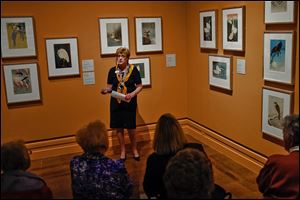
Docent Mary Galvin gives a tour of the exhibit of early modern Japanese prints. The new 135 LED lights are enhancing the experience.
Paul Bernard has an answer to the ever-important question of how many people it takes to change a light bulb.
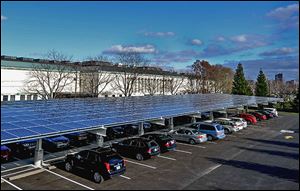
The Toledo Musuem of Art’s new main parking lot features an estimated 300-kw solar panel canopy. The array is owned by a third party that sells its generated power back to the museum.
Just one, he said with a laugh. “It’s labor intensive, though.”
Mr. Bernard is the facilities director for the Toledo Museum of Art. He recently oversaw the installation of 135 LED, or light-emitting diode, bulbs that illuminate the museum’s exhibit of early modern Japanese prints.
It’s the first time the museum has used LEDs to light a gallery. Officials there say the new bulbs will cut costs and be better for the preservation of the artwork.
The superb efficiency of LED lamps has never been in question, but the light quality lagged behind traditional incandescent bulbs.
Not anymore, said Carol Bintz, the museum’s chief operating officer.
“Now the technology is at that place. There’s no reason not to use it,” she said. “It saves us money, it gives us great color quality, lighting quality, and it also has a longer life, so it saves on labor changing light bulbs.”
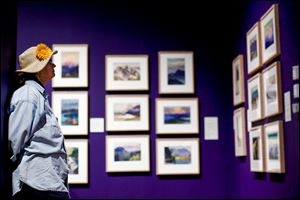
Columbus resident Constance Faddis looks over the exhibit 'Fresh Impressions: Early Modern Japanese Prints' at the Toledo Museum of Art. The LED lighting helps preserve the delicate artwork and enhances the pristine, vivid colors of the prints.
Oh yeah, that changing-the-light-bulb thing.
Reaching a lamp affixed to a 20-foot high ceiling takes some effort. Workers have to navigate carefully the museum’s scissor lift through the corridors and raise themselves up to screw in the new bulb. In all, though, Ms. Bintz said, it takes a couple hours, and workers are nearly constantly having to replace burned-out bulbs.
That should be nearly eliminated by the LEDs. While traditional incandescent bulbs are generally good for four to seven months, the museum expects to get six to seven years out of the LED lamps.
The lighting project is the latest step in a 20-year-old effort by the museum to reduce its energy usage and be more efficient.
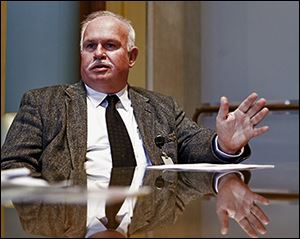
Paul Bernard, facilities chief, says the potential is there to install more energy-saving lighting.
The project started with shoring up the basic systems of a 101-year-old building. More recently, the museum has added natural gas powered microturbines and about 560 kilowatts of solar-generation power.
The results are striking.
In 1991, the year before officials began their search for greater efficiency, the May electricity bill for the museum was $52,000. This May, it was $5,000.
Total power consumption has declined from 6.3 million kilowatt hours in the 1991-1992 fiscal year to 3.9 million kilowatt hours in 2002-2003, to 1.2 million in the 2012-2013 fiscal year.
The museum achieved a milestone of sorts in May, when it for a short time drew all its electricity from its own production. The museum has gone “off the grid” several more times since.
Ms. Bintz said she prefers to talk about the reduction in energy as opposed to monthly savings. She declined to say what the museum spent to install the rooftop solar panels, per an agreement with FirstSolar.
A previous Blade story said the museum expected to spend less than $500,000 on the project’s first phase of 100 kw of capacity. The museum received a $147,500 grant from the Ohio Department of Development in 2008 to offset some of the costs.
The second 100 kw phase was funded in large part through the American Recovery and Reinvestment Act, which contributed $442,904 to the $664,527 project.
A parking lot solar array was installed and is owned by a third party that sells power generated back to the museum at an agreed-to rate. The museum eventually will have the opportunity to purchase the array.
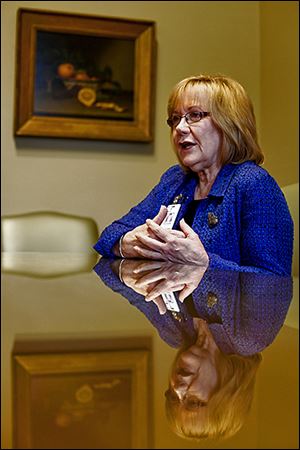
Carol Bintz, chief operating officer, says saving money is now a secondary consideration.
Museum officials are always looking for more opportunities to generate more power or consume less. Mr. Bernard is high on wind power, and he said that he thinks a small turbine would be a great visible landmark for the museum.
Mr. Bernard also said he believes there’s more potential with lighting.
“If we were to take the rest of the museum [to] LED, we could knock another 100 kw off the grid,” Mr. Bernard said. “That’s the equivalent of another phase of solar. That would just be doing it through efficiency. That opportunity’s there.”
An LED lamp costs about $40, while a traditional lamp costs about $7.50. But the durability and energy savings quickly make up the difference, officials say.
“At the end of the show, the lamps are still good,” Mr. Bernard said. “They can be repurposed, so it does get recovered. We’re also generating a lot less heat in here. Our electricity use is way down.”
He said LED lighting projects in the future probably will be phased in. The museum doesn’t have plans for an immediate switch.
That said, the museum couldn’t be happier with how the LEDs have worked out in the gallery showcasing the special exhibit of Japanese art.
“We’re not asking anyone to compromise what they see. In fact we had the two side by side, and the LED, in the opinion of the curator, exceeded the incandescent in terms of the details,” Mr. Bernard said
It’s also a good exhibit to illustrate the importance of keeping works of art protected from harmful light.
The Japanese landscapes on display are brilliant. Vivid blues, delicate pinks, bright reds.
“That’s why this collection is so really remarkable,” Ms. Bintz said. “The colors are so pristine. A lot of people that have had these Japanese prints have exposed them to light, and they’ve washed out.”
Visitors to the exhibit have the rare example to see that degradation side by side. The museum has on display two 1918 wood block prints of the Yaba Gorge. One is faded. The other, bright.
Though the museum is careful to preserve its artwork with all its lighting, the LED gives it an additional advantage in emitting no ultraviolet rays, one of the biggest enemies to art.
“[The art is] pristine, we want to keep it that way, and we want to show it to its best advantage. We got to do all those things with the LED lights,” Ms. Bintz said.
Though the efficiency efforts were started purely as a way to save money, over time she said she began to see their work as part of a greater social responsibility to conserve available resources.
Often asked about the museum’s solar panels and other efficiencies, Ms. Bintz believes the work done in Toledo can be a sort of pilot program for other museums around the world.
“It’s expensive but easy to make a new building have all these energy efficient features, because you start from scratch,” she said. “It’s much harder to take an old building and do that. But if we can do it, so can anybody. You just have to have that as one of your goals.”
Contact Tyrel Linkhorn at tlinkhorn@theblade.com or 419-724-6134.